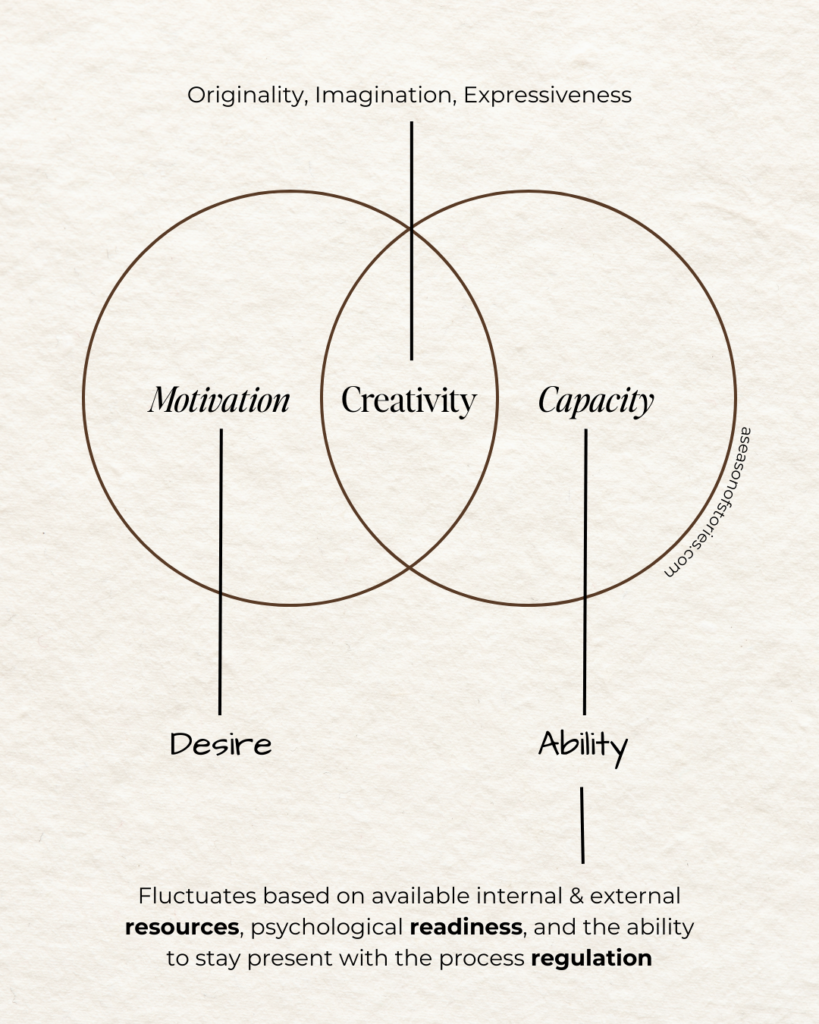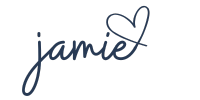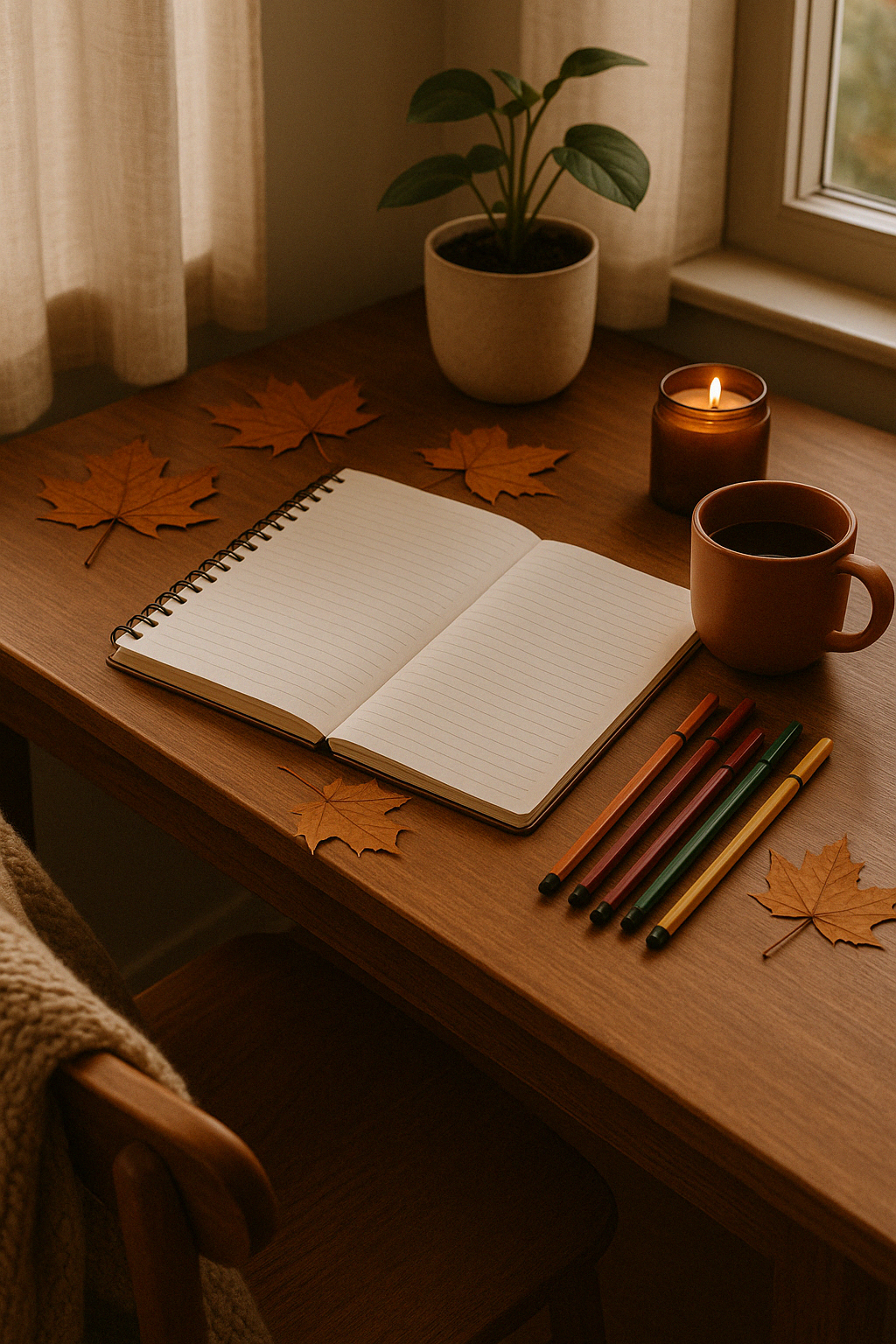Creativity Isn’t Just About Wanting to Make Things
Capacity isn’t a given for any of us.
It’s a fluctuating variable that determines our current ability to take in, process, and respond to life’s demands, including creative work.
It’s shaped by physical, emotional, mental, and social energy.
And unlike motivation, which is often rooted in desire, capacity is about ability.
It’s not whether you want to create; it’s whether you can.
Thinking we are always able to create (no matter what storm is going on in or around us), doesn’t leave room for the messy business of being human.
Too many creatives have stopped creating in the pursuit of living up to the myth that creativity is always at the ready. Or worse, the myth that creativity flows because it’s just who someone is (aka a lucky soul gifted with an infinite well of imagination, talent, and artsy mojo coded right into their DNA).

Capacity and Creative Blocks (aka why is art so hard!)
If you’re trying to muster the courage to start something new (aka the risky business of being a beginner), any creative pursuit can start to bring up resistance.
The muses can be the most elusive during this time because it’s so hard to get past that skill-building stage into a creative flow state.
Decisions about which colour, canvas, character, or genre started to become challenging rather than thrilling.
It doesn’t take long before you find creating art feels hard. You end up stuck, blocked, and unable to start/stick with/finish a piece. A creative block shows up as a day at first, then quickly creeps into weeks, months, years… heck, even decades go by.
At this point, too many of us give up completely on producing any creative outputs because the (psychological) risk of failure* is just too great.
*aka that fear that says if we pursue this any further, we risk proving that we never had any creative ability in the first place.
When Monetizing Art Turns the Creative Process Into a Grind
Decisions about which colour, canvas, character, or genre started to become challenging rather than thrilling.
If you went the route of monetizing your art in any way (be it as an entrepreneur or an employee), and your personal capacity dipped for an extended amount of time, but the demands didn’t, the thrill of creation likely crossed the line from a joyful expression into a grind. You might not be able to pinpoint the exact moment that line was crossed, but here you are thinking, “oh god, now what?”
Or perhaps, like me, you know EXACTLY when your capacity dipped to a subtreanimum level. In that moment, it wasn’t something I wanted to acknowledge, and therefore be responsible for doing something about. I had always been compelled to create after all. Instead of acknowledging it head-on, I stepped away.
Just for a little bit.
At least that was the plan.
But it’s been a while.
A long while.
Are You Missing Your Muses?
Can you relate?
Do you miss it?
Writing just to write?
Moving paint around? Moving pixels around?
Smudging, blending, and moving pastels around?
Feeling wet clay gliding through your fingers?
Looking through your lens during the golden hour?
Finding a rhythm between stitches?
Wandering through the bolts of fabric?
If you’re reading this blog post and you find you’ve stepped away from your creative outlet of choice, you likely miss it, whatever your creative “it” is.
And you’re ready to get back to it.
Or perhaps find a new creative outlet.
But now you’ve got psychological risk lurking around and looking over your shoulder as you try to write, draw, sculpt, or move pixels around the screen.
Eek. Makes sense that we decide that all of this is a tomorrow problem.
I had decided that this was all a tomorrow problem nearly a decade.
Blocked or Depleted? Why the Distinction Matters
If you find yourself at this point, like I did, and things seem pretty bleak, I want to share something that I’ve found to be true for myself. My ability to create comes from a fluctuating and sometimes fleeting combination of available internal & external resources, psychological readiness, and the capacity to stay present with the process through regulation.
It’s not just can I do this?
It’s: Can I do this right now with the time I have available? What state is my nervous system in? While all of this (whatever this is) is happening around me in this exact moment in time?
Spoon Theory and the Creative Life
This isn’t a new concept to those familiar with the Spoon Theory. Spoon theory is a way of explaining what it’s like to live with limited energy, especially for folks with chronic illness, disability, or neurodivergence.
It was created by Christine Miserandino, who used spoons as a metaphor to help her friend understand the daily trade-offs she had to make. Think of it like this: every task costs a spoon—getting dressed, making a meal, answering an email. You start the day with a limited number, and once you’re out, you’re out.
For some of us, that’s the reality behind every decision: constantly budgeting energy, not because we want to say no to things, but because we literally can’t do everything. It’s not about motivation or mindset. It’s about capacity.
If you’ve got enough spoons, seize the day, my friend! And, if we’re ever sitting down for coffee or plant-based milkshakes together, ask me about the time I built my first business, from bed, with a fraction of the spoons I currently find myself possessing.

Start Here: A Gentle Way Back Into the Creative Process
Most days, I think of capacity as a container; the size of the container can change from day to day, depending on factors like sleep, stress, hormones, environment, and other invisible factors. I find it helpful to take an audit now and then about what fills my container and what drains it (there are always consistencies, but some factors that drain vs fill change over time, too).
As someone quick to disassociate from my body, it hasn’t been easy to be mindful (or admit) that I do indeed live within a body with systems that need checking in on. I’m slowly getting better at asking what my nervous system needs right now and taking that information in without judgment, which is also a work in progress.
What does your nervous system need right now?
This is the question I ask myself when I’m tempted to rush through task after task.
It’s the question that helps me go from thinking I didn’t have anything to write about, design, or make, to finding inspiration flood in once again.
How does the simple question “what does my nervous system need right now” do all that?
Well, when I was completely truthful about what my nervous system needed in that moment and did exactly that, I started to slow down. I started opening up space not just in time but in capacity. Capacity to create.
A Simple Check-In That Helped Me Start Creating Again
If you’re skimming, here’s the practice that helped me return to creating after a long break:
- Ask what your nervous system needs right now.
- Answering that question without judgment.
- Then, act on that information (by doing what your nervous system needs).
It wasn’t overnight, but surprisingly, it didn’t take long for the muses to find me.
The puzzle pieces I had been sliding around in my mind for far too long started to click together into a clear picture.
Combined with a few sessions with an empty notepad and some rainbow coloured pens, and here we are. I’m chasing after the next full creative expression of who I want to be in the world, during this season of my life.

If you’re ready to build a business that makes space for your capacity, not just your ambition, The Strategy Studio can help. It’s a quiet, sustainable approach to designing a business model that actually fits your life, even on your lowest-capacity days.
